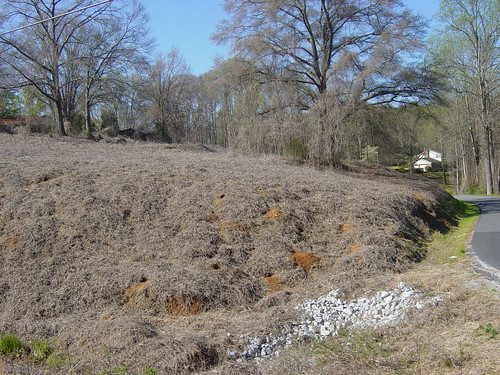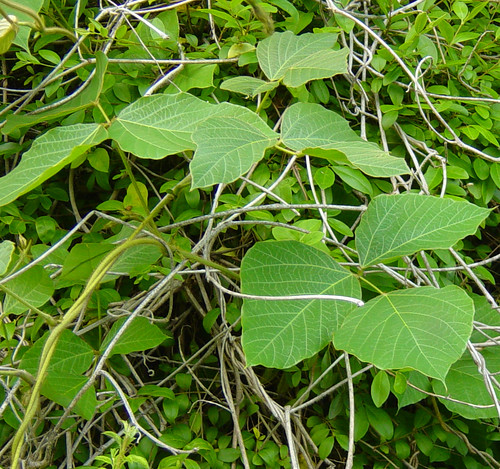Kudzu has been discovered growing in Canada, according to the Toronto Globe and Mail. As you can see from the photo above, kudzu is a vining plant. It happens to be a member of the pea, or Fabaceae family of flowering plants. That means that it has structures in the roots, nodules, which Nitrogen-fixing bacteria can live in. These bacteria take Nitrogen out of the air in the soil, and begin the process of making it available to the kudzu plant, and, thence, to anything that will eat that plant. Nitrogen is found in proteins, and in DNA and RNA, and elsewhere. Living things absolutely must have it in order to exist.
Which brings up a question. How many signs of insect damage (or damage from plant-eating vertebrates, for that matter) do you see in the photo? The answer is none. In spite of kudzu's remarkably rapid growth -- the vines can grow up to a foot a day in good weather -- and that it is a source of protein, it is not eaten readily by many animals. Goats will eat it. I once tried to feed some captive mice some kudzu leaves. Apparently they would gladly have starved to death rather than eating the stuff, so I relented, and put them back on a more normal diet.
Why won't the animals of the Southeastern part of North America, where kudzu grows, eat the plant? Most likely, the answer is that kudzu is not native to that area. It is native to Japan, and parts of China. Presumably, in these areas there are various kinds of insects, and other animals, that eat it. But not in the Southeastern US. When kudzu was brought here, to stop erosion, the animals that eat it were left behind. As a result, kudzu grows almost unchecked. But it is checked. How? by frost. The first common green plant to perish when the weather gets cooler seems to be kudzu. The last plant to start growing in the summer is kudzu. It covers many a hill or field during the time between the first autumn freeze, and the last freeze of the next Spring.
This photo:

Shows how kudzu is anything but green in the winter.
It is not good stewardship to bring non-native living things into an area. They often tend to mess up ths organisms that are already there.



2 comments:
Kudzu was new to me when I first went to SWU from Michigan. I have not so fond memories of cutting it off fences for hours when I worked for Maitenance for work study. I now use Kudzo as a illustration for sin. When I first saw it flowering, I thought it was a beautiful plant. It wasn't until I got to know it better that I realized how harmful it was. Sin is the same way.
Thanks for you Blog. I read often.
Dave Hansen
CWC '91
True. It's a good illustration.
Thanks, Dave.
Post a Comment